Pocket parks bloom in Chinese cities as authorities use marginal or idle land to create leisure spaces for locals within their neighborhoods
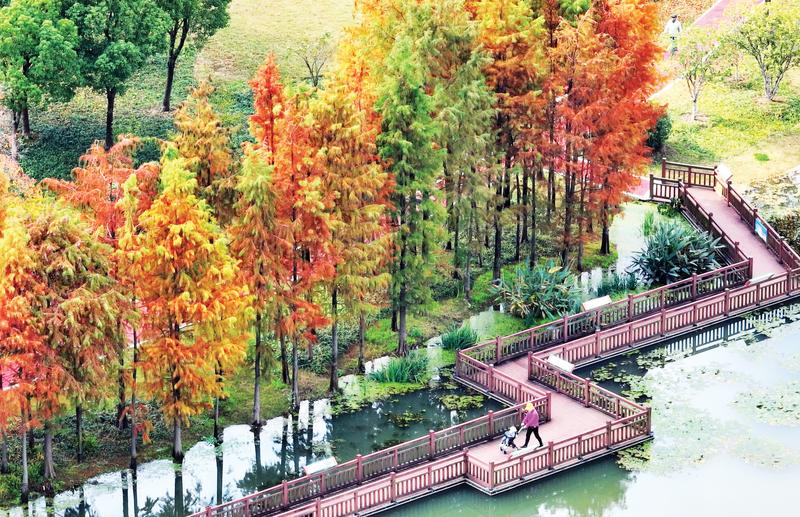 Residents enjoy the autumn scenery at a pocket park in Yangzhou, Jiangsu province, last month. (PHOTO PROVIDED TO CHINA DAILY)
Residents enjoy the autumn scenery at a pocket park in Yangzhou, Jiangsu province, last month. (PHOTO PROVIDED TO CHINA DAILY)
Pocket parks, which typically cover areas of 400 to 10,000 square meters, are springing up in Chinese cities.
In September, a neglected garden in Dalian, Liaoning province, was transformed into a 1,280-square-meter mini park.
Chen Ming, 65, who lives in one of two six-story residential buildings next to the park, located in Huayuan Lane, Xigang district, said: “This park is now a wonderful place for recreation. It’s hard to imagine it was once covered in grass and weeds, where rundown flower beds were used by some people to grow vegetables.”
The new leisure area is extremely popular with local residents, Chen said.
Students run and play in the park after school, middle-aged and elderly residents dance and exercise there in the evening, and people heading for walks in the nearby hills take short breaks on the park’s wooden benches.
Chen, who has lived in the area for 42 years, said: “I also like walking in the hills, which are known for their wild sika deer. As the environment has improved, animals that disappeared have returned in recent years, and I’ve seen rabbits, pheasants and badgers in the area.
“It is great to have this beautiful mini park right on our doorstep, and it is particularly convenient for the elderly.”
 Children play at a pocket park in Hohhot, Inner Mongolia autonomous region, in May. (DING GENHOU / FOR CHINA DAILY)
Children play at a pocket park in Hohhot, Inner Mongolia autonomous region, in May. (DING GENHOU / FOR CHINA DAILY)
The transformation of the area was based on its original topography, with apricot, cherry and pine trees being planted by residents.
When locals were consulted on the design, Chen suggested placing handrails next to steps in the park to assist the elderly. He is pleased to see the handrails every time he passes by.
The park was completed within one month, and the work involved tidying up the land, replanting, and installing a porch, benches and other facilities.
Ma Yanxia, deputy head of the Shidaojie residential community, said: “Everyone living here wants a more beautiful environment and a more convenient place for leisure activities. Many residents have asked us to turn public spaces near their buildings into pocket parks, but I don’t think we can afford this now.”
In recent years, the northeastern port city of Dalian has worked to introduce more green zones by cleverly using vacant neighborhood spaces to provide residents with “natural gardens” for walking, admiring the scenery, and generally relaxing.
This year, 112 pocket parks were expected to be constructed locally, according to the Dalian City Administration Bureau. These parks would be scattered throughout the city — next to office buildings, at the end of roads, or in residential neighborhoods. They provide places of quiet refuge to escape busy city life.
Ding Ning, an official at the bureau’s greening department, said designing and constructing Dalian’s pocket parks calls for outstanding features, ecological priority and excellence, and a commitment to maximizing green coverage and making best use of even the smallest area.
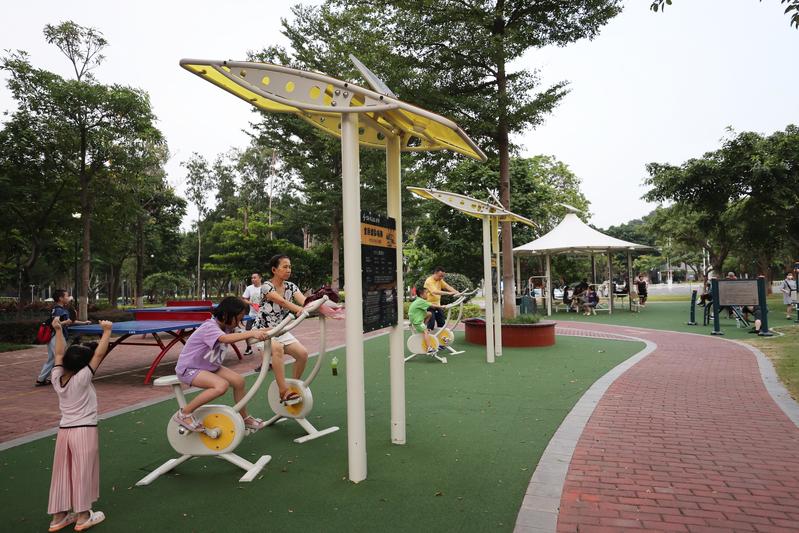 Residents exercise and play table tennis at a pocket park next to a compound in Huli district, Xiamen, Fujian province. (ZENG DEMENG / XINHUA)
Residents exercise and play table tennis at a pocket park next to a compound in Huli district, Xiamen, Fujian province. (ZENG DEMENG / XINHUA)
The mini parks, which used to be vacant or abandoned areas, have been fitted with benches, seats, lighting, fitness and entertainment equipment, sun and rain shelters, and toilets.
“We also consider the needs of children, the elderly and the disabled, and try to install some barrier-free and children’s amusement facilities,” Ding said.
When it comes to greening, priority is given to indigenous plants. Based on the original plant varieties, replanting work involves using a reasonable amount of shrubs and bulbous plants to provide a landscape offering good views in all seasons.
In accordance with national, provincial and municipal policies, pocket park construction in Dalian is organized by the city’s administration bureau and carried out by government institutes in districts and counties, Ding said.
In Xigang, this work is performed by the district government’s urban utilities service center.
Liu Weiguo, who is in charge of the center’s pocket park construction work, said: “These mini parks are small oases in urban settings. People living nearby are both beneficiaries and participants.”
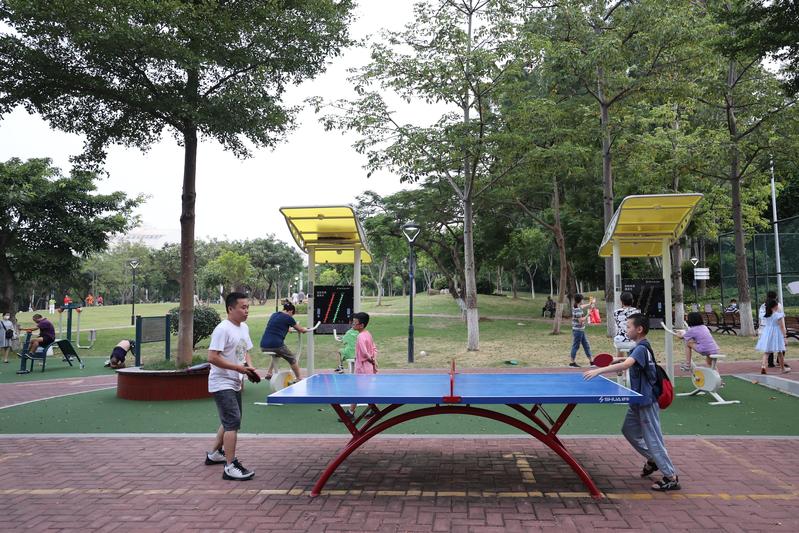 Residents exercise and play table tennis at a pocket park next to a compound in Huli district, Xiamen, Fujian province. (ZENG DEMENG / XINHUA)
Residents exercise and play table tennis at a pocket park next to a compound in Huli district, Xiamen, Fujian province. (ZENG DEMENG / XINHUA)
He said the aim of building mini parks is to better serve residents, adding that the needs of local people, especially those using the parks frequently, should be considered.
“We sought advice from the public, and made efforts to adapt our designs and construction plans to meet their needs,” Liu said.
From April to October, construction of 12 new pocket parks was completed in Xigang, mostly in areas that had been abandoned.
The parks feature lawns, children’s playgrounds, fitness greenways, squares and other areas for leisure activities, social gatherings, walking, entertainment and cultural displays.
Liu said the district plans to build 10 new pocket parks next year.
In recent years, Chinese provinces and cities have viewed the construction of pocket parks as an important measure to improve urban living environments. Such neighborhood parks are being increasingly introduced.
For example, 1,295 mini parks were built in Liaoning province last year.
A provincial-level meeting on the construction of pocket parks, held in Shenyang, capital of Liaoning, in July urged cities to regard such work as an important task.
 Bubbles attract a child's attention at a pocket park in Chengde, Hebei province. (WANG LIQUN / XINHUA)
Bubbles attract a child's attention at a pocket park in Chengde, Hebei province. (WANG LIQUN / XINHUA)
Li Haiyang, a former deputy mayor of Dalian and now secretary-general of the Communist Party of China Dalian Municipal Committee, said: “Dalian is actively exploring an efficient management mode by introducing volunteer residents to take part in maintaining neighborhood parks.”
For mini parks in old residential communities that have no management companies, government departments provide kettles, fertilizers, pest control drugs and cleaning tools, while community staff members guide volunteers in contributing to the maintenance and upkeep of the parks.
Dalian, located on the southern tip of the Liaodong Peninsula, is an important port city in Northeast China that has introduced a three-level system involving suburban, city and neighborhood parks.
Li said Dalian, which now boasts more than 700 pocket parks and small street gardens, expects to build another 500 mini parks by 2025. The local government is helping real estate developers take part in building parks.
“Taking advantage of urban regeneration and renovation work in old residential communities, we are gradually building pocket parks in more neighborhoods and back lanes,” Li said.
China aimed to build at least 1,000 pocket parks this year to help solve the problem of a shortage of public green spaces, according to a statement published by the Ministry of Housing and Urban-Rural Development in August.
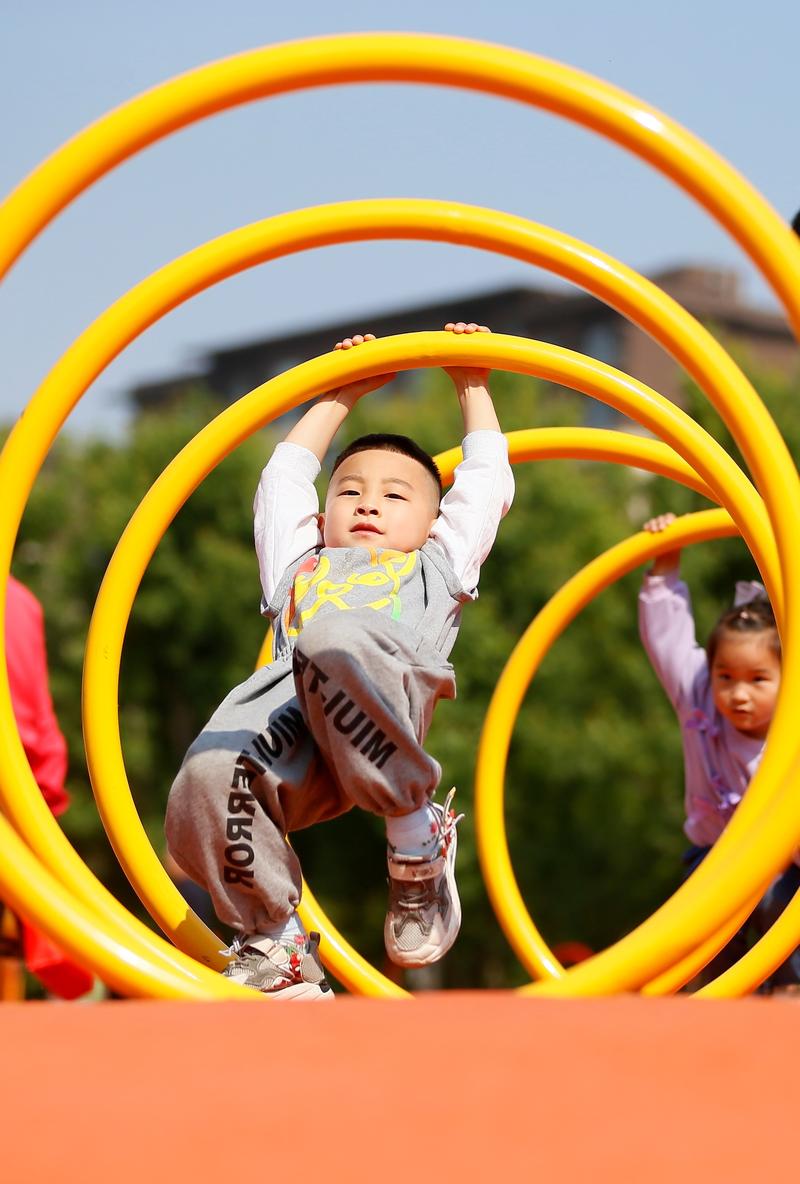 A child plays at a pocket park in Qingdao, Shandong province. (LIANG XIAOPENG / XINHUA)
A child plays at a pocket park in Qingdao, Shandong province. (LIANG XIAOPENG / XINHUA)
Each provincial-level region was required to build at least 40 such parks this year. Local authorities should prioritize the choice of indigenous plants for the parks, and give full consideration to the needs of nearby residents in building these areas, the statement said.
Yang Hongyi, deputy head of the ministry’s urban construction department, told China Central Television: “Due to space limitations, it is increasingly difficult to build large integrated parks in cities. Building pocket parks in old urban areas with high-density populations can be an important measure to make up for the shortage of green space and uneven distribution of parks.”
In August 2020, the Ministry of Housing and Urban-Rural Development and other ministries and administrations issued a statement aimed at launching action to tackle “areas of weakness” in constructing urban residential communities.
At least one neighborhood park of no less than 4,000 sq m must be built at newly constructed residential communities. Existing residential communities are encouraged to transform marginal, abandoned and idle land into pocket parks.
Construction guidelines have been introduced locally in provinces and municipalities.
In early November, the Department of Housing and Urban-Rural Development in Jiangsu province released such guidelines for pocket parks.
The guidelines state that these parks should be mainly constructed on six types of land: abandoned spaces and land that has not been used for a long time; small plots vacated after the demolition of buildings and other structures; narrow spaces between walls, buildings and sites; small green spaces with a low rate of use, corner areas of roads and bridges, and spaces under bridges; closed ornamental green spaces such as green belts alongside roads; and small squares with a low rate of use.
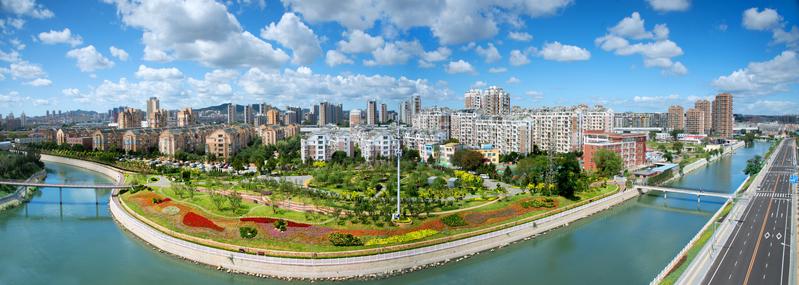 A pocket park stands alongside a residential community in Ganjingzi district, Dalian, Liaoning province. Such parks are opening in numerous cities across China. (PHOTO PROVIDED TO CHINA DAILY)
A pocket park stands alongside a residential community in Ganjingzi district, Dalian, Liaoning province. Such parks are opening in numerous cities across China. (PHOTO PROVIDED TO CHINA DAILY)
The department also proposed using information technology to improve the efficiency of pocket park management and service levels.
In September, the Shanghai Development and Reform Commission and the municipal landscaping and city appearance administrative bureau released special supporting measures for the construction of pocket parks and street parks.
The measures state: “Upon completion and acceptance of a project, one-time municipal subsidies will be given according to the project construction standard and construction quantity. The upper limit of the subsidy standard is 300 yuan per sq m.”
The first pocket park in Shanghai was launched in September 2015. After the demolition of a 100-m-long wall beside a well-known hotel, a 4,400-sq-m garden opened to the public at the intersection of Donghu Road and Middle Huaihai Road.
As of last year, the city had built or upgraded 310 pocket parks with a total area of 1.12 million sq m, according to the municipal landscaping and city appearance administrative bureau. Shanghai plans to have 1,000 pocket parks by 2025.
The Ministry of Housing and Urban-Rural Development said nearly 30,000 pocket parks have been constructed or renovated to meet requirements that residents “should be able to see green coverage within 300 meters and a garden every 500 meters”.
In Liaocheng, Shandong province, neighborhood parks themed on magpies, gourds, paper-cutting and other local features have become new landmarks.
A pocket park in Gurong Lane, Quanzhou, Fujian province, features traditional Minnan architecture.
In June, a themed pocket park was completed in Weichang Manchu and Mongolian autonomous county, Chengde, Hebei province, home to Saihanba National Forest Park, China’s largest man-made woodland. Residents and visitors learn how the first generation of foresters worked at the Saihanba Machinery Forest Farm.
Liu Jun, director of the Hebei urban landscaping service center, said, “In addition to their practical functions, we hope that pocket parks can showcase some of a city’s historical and humanistic characteristics.”
To date, 1,049 pocket parks have been built in the province, according to the Hebei Department of Housing and Urban-Rural Development.
Liu said the construction of mini parks in Hebei is dominated by government investment and supplemented by social capital, adding, “By introducing more social forces, we are jointly building a pleasant living environment.”
This year, Xingtai, Zhangjiakou, Dingzhou and other cities in Hebei have encouraged public units, enterprises, social organizations and individuals to take part in the construction of pocket parks in order to expand funding channels and reduce pressure on government funds.
Cities are also exploring more sustainable management and maintenance modes for pocket parks. In Jize county, Handan, local residents are helping maintain five pocket parks, while 11 such parks are cared for by local public institutions.
The first thing that Li Shuangtian, a voluntary keeper at a mini park near his home in Jize, does when he arrives at the park in the morning is check whether garbage needs clearing, or if any equipment has to be reported for repairs. Then he starts his exercises.
“As long as we devote enough time and energy to them, pocket parks can play a long-term role in better serving residents,” Liu said.
Song Ping contributed to this story.
Contact the writers at zhangxiaomin@chinadaily.com.cn


